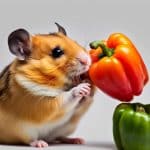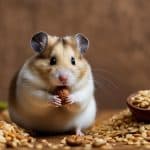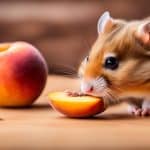Hamsters are adorable and curious creatures, always exploring and nibbling on various foods. As a hamster owner, you may be wondering if it’s safe to feed your furry friend corn. While hamsters can eat corn, there are a few things you should know to ensure their health and well-being.
Corn is not the most nutritious food option for hamsters. It is rich in carbohydrates, low in fat and protein, and contains high levels of sugar and fiber. While it can provide some vitamins and minerals, it should only be offered as an occasional treat rather than a regular part of their diet.
It’s important to note that not all hamsters react the same way to corn. Dwarf hamsters, such as Campbell Dwarf, Russian Dwarf, and Winter White Dwarf hamsters, should not consume corn due to their higher risk of obesity and diabetes. For other hamster breeds, corn should still be offered in moderation.
If you decide to feed corn to your hamster, it should be thoroughly washed and cooked. Additionally, only offer small amounts to avoid potential risks such as choking, obesity and diabetes, and gastrointestinal problems. It’s also essential to avoid corn husks, cobs, canned corn, cornmeal, creamed corn, or pickled corn, as these can be harmful to your furry friend.
When it comes to your hamster’s overall diet, a well-balanced approach is crucial. Consider incorporating other healthy alternatives such as fruits and vegetables like pears, apples, lettuce, and broccoli. These options can provide a better source of nutrients for your hamster’s nutrition and well-being.
Key Takeaways:
- Hamsters can eat corn, but it should be given in moderation as a treat.
- Dwarf hamsters, such as Campbell Dwarf, Russian Dwarf, and Winter White Dwarf hamsters, should avoid corn due to their higher risk of obesity and diabetes.
- Thoroughly wash and cook corn before offering it to your hamster to minimize potential risks.
- Avoid feeding your hamster corn husks, cobs, canned corn, cornmeal, creamed corn, or pickled corn.
- Consider incorporating other healthy alternatives like fruits and vegetables into your hamster’s diet for a well-balanced nutrition.
What Does a Healthy and Well-Balanced Hamster Diet Look Like?
A healthy and well-balanced hamster diet plays a crucial role in maintaining your furry friend’s overall health and well-being. To ensure that your hamster receives all the essential nutrients it needs, it is important to provide a variety of foods that mimic its natural diet.
First and foremost, a significant part of a hamster’s diet should consist of commercial pelleted hamster food. These specialized pellets are formulated to contain the right balance of essential nutrients, including proteins, carbohydrates, fats, and fiber. Make sure to choose a high-quality pellet brand that caters specifically to hamsters’ nutritional requirements.
In addition to pelleted food, it is beneficial to supplement your hamster’s diet with small amounts of fresh vegetables and fruits. These should be given as occasional treats, as hamsters require a smaller portion of fresh produce compared to their main pellet-based diet. Including vegetables and fruits enhances variety and provides additional vitamins and minerals.
When choosing vegetables, opt for options like carrots, spinach, and broccoli. These choices are generally safe and nutritious for hamsters. Fruits such as apples, pears, and bananas can also be given in moderation. Remember to remove any uneaten fresh food after a few hours to prevent spoilage and potential health risks.
Furthermore, access to fresh water is vital for your hamster’s hydration. Make sure to provide a clean water source in a water bottle or shallow dish that your hamster can easily access. Monitor the water supply regularly to ensure it remains fresh and available throughout the day.
Essential Nutrients for Hamsters
When it comes to essential nutrients, a well-balanced hamster diet should provide the following:
- Protein: Hamsters require a diet that contains approximately 15-25% protein. Good sources of protein include high-quality hamster pellets and small amounts of cooked meat, boiled eggs, or mealworms.
- Carbohydrates: Carbohydrates should make up around 35-40% of a hamster’s diet. They can be obtained through specialized hamster pellets, grains, and limited servings of vegetables and fruits.
- Fat: Hamsters need approximately 4-5% fat in their diet, which can be obtained from high-quality hamster pellets, seeds, and small amounts of nuts or unsalted peanut butter.
- Fiber: Crude fiber should comprise around 5% of a hamster’s diet. This can be achieved through a combination of hamster pellets, hay, and vegetables.
Additionally, to mimic a hamster’s natural foraging behavior, you can provide seeds, insects, larvae, crickets, and cereals in small amounts as a treat. These options offer stimulation and mental enrichment for your hamster.
A healthy and balanced hamster diet helps promote a long and active life for your furry companion. By providing the right balance of commercial hamster food, fresh vegetables, fruits, and access to water, you can ensure that your hamster receives all the essential nutrients it needs for optimal health and well-being.
Can All Hamsters Eat Corn?
While hamsters can eat corn in moderation, not all hamster species tolerate it well. Syrian and Roborovski hamsters can enjoy corn as a treat, but it is important to note that corn should not be a regular part of their diet. On the other hand, dwarf hamsters such as Campbell Dwarf, Russian Dwarf, and Winter White Dwarf hamsters should not consume corn due to their higher risk of obesity and diabetes. Therefore, it is crucial to consider the specific breed of your hamster before offering corn as a food option.
It is worth mentioning that a hamster’s diet plays a significant role in their overall health and well-being. While corn can be safely consumed by certain hamster species, it is essential to remember that each hamster is unique, and their nutritional needs may vary.
Is Corn Safe for Hamsters?
While corn can provide some nutritional benefits to hamsters, it is not the healthiest food option. Corn is low in protein and fat but high in carbohydrates and sugar, making it less ideal for a hamster’s diet. Additionally, corn contains an acidic component that can cause gastrointestinal upset in hamsters if consumed in large amounts.
Although corn is often included in commercial hamster pellets for its quick energy boost, it is not a high-quality energy source for hamsters. The sodium content in canned corn, creamed corn, and pickled corn can also be harmful to hamsters, potentially leading to urinary problems and kidney issues.
If you choose to include corn in your hamster’s diet, it is important to exercise caution. Offer it in moderation and as a treat rather than a staple food. Remember to thoroughly wash and cook the corn before feeding it to your hamster, and avoid offering corn husks, cobs, and corn products high in sodium.
Possible Risks of Feeding Corn to Hamsters
Feeding corn to hamsters can pose several risks. Corn kernels can be a choking hazard for hamsters, so it is important to offer bite-sized pieces that are easy to chew. In dwarf hamsters, the high carbohydrate and sugar content in corn can contribute to obesity and diabetes. Some hamsters may also experience gastrointestinal upset, diarrhea, or vomiting after consuming corn. It is particularly important to avoid feeding hamsters canned corn, creamed corn, or pickled corn as these products often have high sodium levels, which can lead to urinary problems and kidney issues.
Conclusion
In conclusion, while hamsters can eat corn, it is important to offer it in moderation and as a treat rather than a staple in their diet. Corn is not the most nutritious option for hamsters, especially for dwarf hamster breeds that are prone to obesity and diabetes. To ensure your hamster’s overall health and well-being, it is recommended to explore healthier alternatives for their diet.
Fruits and vegetables can provide a better source of nutrients for your hamster. Consider incorporating treats like pears, apples, lettuce, and broccoli into their diet. When offering corn, make sure to wash it thoroughly, cook it, and provide it in small amounts. Avoid giving them corn husks, cobs, or corn products that are high in sodium.
By providing a balanced and varied diet, you can give your hamster the nutrition they need while reducing the risk of health issues associated with corn consumption. Remember to always prioritize the well-being of your furry friend and consult with a veterinarian if you have any concerns about their diet or specific dietary requirements.
FAQ
Can hamsters eat corn?
Yes, hamsters can eat corn, but it should be offered in moderation and only as a treat.
Is corn a safe food for hamsters?
Corn can be safe for some hamsters, but certain breeds, like dwarf hamsters, should avoid it due to their higher risk of obesity and diabetes.
How should corn be prepared for hamsters?
Corn for hamsters should be thoroughly washed, cooked, and offered in small amounts.
Are there risks associated with feeding corn to hamsters?
Yes, there are risks such as choking hazards, obesity and diabetes, and gastrointestinal problems that can arise from feeding corn to hamsters.
What should I avoid when feeding corn to my hamster?
You should avoid offering corn husks, cobs, canned corn, creamed corn, or pickled corn to your hamster.
What should a healthy and well-balanced hamster diet include?
A healthy hamster diet should include commercial pelleted hamster food, small amounts of vegetables and fruits, and access to fresh water.
Can all hamster species eat corn?
While some hamster species can eat corn as a treat, dwarf hamster breeds like Campbell Dwarf, Russian Dwarf, and Winter White Dwarf hamsters should avoid it.
What are the possible risks of feeding corn to hamsters?
The risks include choking hazards, obesity and diabetes, and gastrointestinal problems.
What are the alternatives to corn for hamsters?
Some healthier alternatives for hamsters include fruits and vegetables like pears, apples, lettuce, and broccoli.











